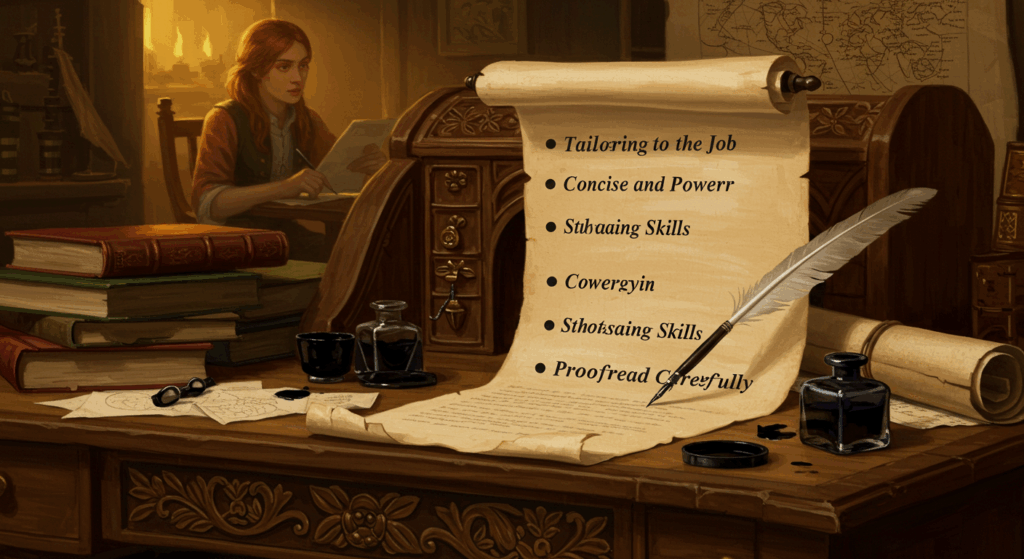So You’re Writing a Cover Letter (and Low-Key Dreading It)
Real talk: writing a cover letter can feel like the job before the job. You’ve got a résumé that slaps, a LinkedIn that’s… decent enough, and then this little one-page note is like, “hey, convince a stranger you’re worth interviewing—in 300 words and zero cringe.” Love that for us.
But here’s the good news: a cover letter is not a pop quiz. It’s your chance to steer the conversation before the interview even starts. Done right, it’s basically your highlight reel, your vibe check, and your “trust me, I can do the thing” all in one. And we’re going to do it in a way that doesn’t sound like a robot from 2003.
This guide covers everything—from how to plan, what a solid cover letter format looks like, the tone that reads as a professional cover letter (without being stiff), and examples you can steal/adapt. We’ll keep it casual, helpful, a little messy in a human way (ngl, I’ll toss in a “hmm” or two), and definitely copy-paste-ready for your WordPress blog or wherever you share your wisdom.
Let’s get into it.
What a Cover Letter Actually Does (and Why Hiring Managers Still Care)
Think of the cover letter as an intro track before your album drops. Your résumé lists facts; your letter connects dots. It answers:
- Why this company?
- Why this role?
- Why you (specifically), now?
Even if the posting says “optional,” a tight letter can separate you from the swarm of equally qualified people. When a recruiter is comparing two similar résumés, the one with a thoughtful letter usually wins. It shows effort. shows fit. It shows you can write like a real person. (Hot take: the last part matters a lot.)
Before You Write: Get Your Angle
If you open a blank doc and try writing a cover letter line-by-line with zero prep, you’ll want to scream into your pillow. Do this first:
That’s your angle. Everything else hangs off it.
The Core Cover Letter Format That Just Works
Yes, there are creative ways to do it. But if you want a reliable cover letter format, here’s the clean, ATS-friendly (and human-friendly) structure:
- Header: Your name, email, phone, LinkedIn/portfolio, city (optional). Match your résumé style so it feels cohesive.
- Date + Company Info: Date, hiring manager’s name (if known), company name, role title.
- Greeting: “Hi [Name],” is perfectly fine. If unknown, “Hi [Team Name] Hiring Team,” works. Skip “To Whom It May Concern” unless you’re time-traveling.
- Opening Paragraph (Hook): A quick, genuine reason you’re excited + 1 aligned strength.
- Body Paragraph(s): 1–2 short paragraphs with proof (metrics, outcomes). Use a mini-story format (STAR or setup → action → result).
- Closing (Call-to-Action): Reaffirm fit, suggest next step, thank them.
- Signature: “Best,” your name. If it’s an email body, include your contact block below.
A Note on Length and Style
- Length: 250–400 words is the sweet spot. Two thirds of a page looks intentional. A full page is… a lot.
- Font & Spacing: 10.5–12pt, 1.0–1.15 line spacing. Keep margins at ~1”. Use the same font as your résumé for a professional cover letter look.
- File Name:
Firstname-Lastname-Cover-Letter-Company-Role.pdf - Tone: Clear, confident, specific. Warm, not gushy. No corporate bingo (“synergize KPIs at scale”). Say things like a person would.
The Voice: Professional, Not Pretend-Robot
The trick with writing a cover letter is sounding like you—on your best day. You can be friendly and still be sharp. A few tone moves:
- Use active verbs. Built, launched, led, analyzed, designed, consolidated, negotiated, shipped, debugged.
- Cut filler. If you can say it in seven words, don’t use seventeen.
- Show, don’t list. One concrete example beats a pile of adjectives.
- Mirror their language—but lightly. If they say “customners,” don’t say “users.” If they say “impact,” say “impact” (once), not “leverage for cross-functional impact sizing at scale” (please no).
Openings That Instantly Raise Eyebrows (in a good way)
Your first 1–2 sentences decide whether they keep reading. Try one:
- The “Mission Match” Hook:
“I’m applying for the Product Designer role because your mission—simplifying financial tools for first-time investors—hits close to home. I’ve built onboarding flows that helped 60k+ new users get comfortable fast.” - The “Relevant Win” Hook:
“In my last role, I cut ticket resolution time by 38% while boosting CSAT to 4.7/5. I’d love to bring that energy to your Support Lead opening.” - The “Recent Launch” Hook:
“After your Series B and the new marketplace launch (very cool btw), you need someone who can scale creator onboarding—exactly what I did at X, growing active creators 120% in six months.”
Notice: simple, specific, human. No throat-clearing.
Writing a Cover Letter: Your Step-by-Step Flow
Step 1: Draft Your Bullets (Not Sentences)
Start with two or three mini bullet points that prove your angle. Example:
- Reduced onboarding drop-off from 45% → 21% by A/B testing tour timing, tooltips, and simplified email sequence.
- Built a cross-functional “first 7 days” dashboard; exec team used it weekly to prioritize dev sprints.
Now you’ve got content. Sentences come later.
Step 2: Turn Bullets into Micro-Stories
Use quick STAR logic: situation → task → action → result. Keep it to 2–3 lines per story.
“When churn spiked in month 2 (situation), I was asked to diagnose onboarding gaps (task). I mapped the first-week user journey and tested three variations (action), which cut drop-off by 24% in a quarter (result).”
Step 3: Connect Your Stories to Their Needs
Explicitly tie each story to the JD:
“Because you’re prioritizing activation and retention, I’d bring the same experimentation playbook here.”
Step 4: Close with Momentum
End with a forward pull:
“I’m excited to show you the ‘first-7-days’ dashboard in more detail and chat about your Q4 activation goals.”
Examples You Can Adapt (Please, customize!)
Example 1 — Professional Cover Letter for a Marketing Role
Hi Jordan,
I’m excited to apply for the Growth Marketing Manager role at Lumen. Your focus on ethical, zero-party data is exactly where I’ve spent the past two years. Most recently, I led lifecycle experiments that lifted trial-to-paid conversions by 19% quarter-over-quarter.
At Brightly, I owned email and in-app messaging for 400k+ subscribers. I rebuilt our segmentation with consent-first fields, then launched a three-touch onboarding series that reduced time-to-value by 32%. I also partnered with product to ship contextual tips inside the dashboard; engagement in week one rose from 43% to 61%.
Because your JD emphasizes activation and retention, I’d bring the same hypothesis-driven approach—clear metrics, tight tests, fast learnings. I love that you publish your experimentation notes (rare!). I’m already thinking about how we could test a light-weight “progress bar” inside your trial flow.
Thanks for considering my application. I’d love to share a few screenshots of the omboarding series and talk through ideas for Lumen’s Q4 growth plan.
Best,
Ava Lopez
[LinkedIn] • [Portfolio] • [email] • [phone]
(Note the simple cover letter format: hook, proof, relevance, close. Professional but not stiff.)
Example 2 — Early Career / Internship
Hi Hiring Team,
I’m a Computer Science junior who loves building small things that feel big. For my capstone, I led a three-person team to create a React app that helps students find campus resources. We shipped v1 in six weeks; 1,200 students used it during finals week (and the help desk noticed the drop in repetitive questions).
Two parts of your posting jumped out—pair programming and mentorship. I’ve been a peer tutor in our CS lab for four semesters, so I’m comfortable asking questions and giving feedback respectfully. I’d be excited to learn your codebase and contribute to accessibility improvements in your mobile app.
Thanks for your time. I’d love to share the repo and a quick Loom demo if helpful.
Best,
Riley Chen
(Short, warm, and still a professional cover letter.)
Example 3 — Career Switcher (Operations → UX)
Hi Aria,
I’m applying for the Associate UX Researcher role. After five years in operations, I shifted into UX because I kept solving the wrong problems—fast—when the right move was to pause and listen. In my certificate program, I ran six moderated interviews for a budgeting app concept and synthesized 300+ notes into three themes that shaped the MVP.
Previously, as an Ops Lead at Parcel, I cut warehouse mis-sorts 41% by observing how packers worked and simplifying label steps (yes, I love a sticky note). That same observational instinct is what I’ll bring to your research team as you improve onboarding for first-time users.
I’m including a brief case study; happy to walk through methodology and what I’d do differently next time.
Best,
Maya Patel
Make It Skimmable: Formatting That Respects Busy Eyes
A readable cover letter format is everything. Some quick wins:
- Short paragraphs (2–4 lines). Avoid walls of text.
- Meaningful bolding for 1–2 key metrics—not every sentence.
- White space is your friend. It makes your ideas look confident.
- Plain links (no tracking monsters). If attaching a PDF, ensure links are clickable.
- Accessibility check: Good contrast, readable font, descriptive link text.
And yes, PDFs are generally safer than DOCX for layout. If the portal prefers text, paste cleanly—no weird spacing or emojis unless the culture clearly invites it (I love emojis, but not all hiring managers do, hmm).
The Content That Matters Most (Spoiler: Outcomes)
When you’re writing a cover letter, your outcomes are the star. You don’t need 10. Pick 2–3:
- Revenue / Growth: “Grew MRR 14% by launching (X).”
- Efficiency: “Cut processing time 35% by (Y).”
- Quality: “Reduced defects 28% after implementing (Z).”
- Experience: “Lifted NPS from 42 → 58 in two quarters.”
- Scale: “Supported 120+ enterprise customers with 98% renewal.”
Translate your work into impact, not tasks. “Owned weekly reporting” is fine; “Built a reporting cadence that exposed a churn signal and saved $120k ARR” is better.
Tailoring Without Losing Your Soul
Please don’t write one generic professional cover letter and blast it to 57 postings. That’s like sending the same “hey” to every match on a dating app. (We’ve all seen how that goes.)
Do this instead:
- Swap the angle line. One sentence near the top that matches their mission or product.
- Match 2–3 keywords from their JD, naturally.
- Choose the best two proof points for that role.
- Add one sentence that shows you read a blog post, watched their demo, or noticed a recent milestone.
That’s 5–7 minutes of tailoring. Worth it.
Common Mistakes (and Easy Fixes)
- Repeating your résumé line-for-line.
Fix: Use the letter for context and why-this-company energy. - Vague claims.
Fix: Quantify (“reduced by 24%”) or get concrete (“supported 12 enterprise accounts across APAC”). - Passive language.
Fix: Swap “responsible for” → “led/built/created.” - Over-apologizing.
Fix: If you’re missing a skill, reframe: “While I’m newer to SwiftUI, I learn quickly; in my last role I picked up Kotlin and shipped two features in Q2.” - Too long.
Fix: Aim for 300 words. Say the thing, then stop. - Typos.
Fix: Read out loud once. Then once more. (Seriously. Your ear catches what your eyes skip.)
Tailored Tips by Role/Field
- Design: Link a portfolio page that mirrors the job (mobile if they’re mobile). Mention accessibility or usability testing—instant credibility.
- Engineering: Choose one technical win and one collaboration win. Hiring managers want to know you can code and communicate.
- Marketing: Show you understand the funnel and can be held to numbers.
- Sales / CS: Name your quota/renewal metrics. Include an example objection you consistently overcame.
- Ops / Admin: Emphasize systems you improved, cost/time saved, and “quiet hero” wins.
- Education / Nonprofit: Impact stories and community understanding matter. Keep it values-aligned without sounding performative.
- Creative / Content: Drop 1–2 links to your best pieces and mention your editorial POV, tone range, or audience segments.
ATS, Email, and Upload Portals (aka “Does the Robot Even See This?”)
- ATS rarely parses cover letters as deeply as résumés, but keywords still help with internal searches. Use a few JD phrases naturally.
- If you email it, put your letter in the email body (shorter version) and attach the full PDF if requested. Subject line: “Application — [Role] — [Your Name].”
- If you paste to a portal, check formatting after submit (line breaks can get weird).
- If they ask for “Why us?” in a field, that’s your opening paragraph—use it there and keep your attached letter focused on proof.
How to Sound Like You (But Sharper)
Try this quick polish pass:
- Underline your verbs. Replace weak ones.
- Circle any adverbs (“really,” “very,” “deeply”). Cut most of them.
- Read once for rhythm. If you run out of breath, add a period.
- Swap clichés (“fast-paced environment,” “self-starter”) for specifics.
- Sprinkle warmth. One “I’m excited” or “I’d love to” is enough. (Two is still okay. Seven = no.)
Micro-Templates You Can Steal
Template A — Classic Professional Cover Letter
Greeting
Hi [Hiring Manager Name],
Hook
I’m applying for the [Role] at [Company] because [specific mission/product/goal] aligns with my experience in [skill area].
Proof
At [Current/Last Company], I [action], resulting in [metric/outcome]. I also [second action] to address [problem], which led to [result].
Tie-Back
Because your JD emphasizes [priority], I’d bring [skill/tool/approach] to help [outcome you’ll drive].
Close
Thanks for your time. I’d love to share more about [asset/demo/example] and learn abut your plans for [team/roadmap/timeframe].
Best,
[Your Name]
[LinkedIn] • [Portfolio] • [Email] • [Phone]
Template B — Concise Email Body (Paste-Friendly)
Hi [Name] — excited about the [Role] at [Company].
Two quick wins I’d bring:
- [Outcome with metric] by [action].
- [Outcome with metric] by [action].
I’m attaching my résumé and portfolio. Would love to share a quick demo or hop on a short call next week.
Best,
[Your Name]
FAQ (Because Your Brain Is Already Asking)
Do people even read these?
Some do, some skim. But when they’re on the fence about you? The letter decides.
What if I don’t meet every requirement?
Few do. Hit the core 60–70%, then show you can learn the rest (with a real example of learning fast).
Can I use AI to draft it?
Yep. But personalize the hook and the proof. The human edit is the difference between “eh” and “ooh.”
Should I use a design-heavy template?
If you’re in design/creative, a little styling is fine. Otherwise, clean and readable wins. The cover letter format we outlined is safe for most roles.
How many times should I say “professional cover letter”?
Say it when you mean it. (Meta moment: you’re writing one right now.)
A Quick Checklist Before You Hit “Send”
- One clear angle that matches the JD.
- Two strong proof points with outcomes.
- A tone that feels like you (on a good day).
- A tidy cover letter format and filename.
- Links work; portfolio highlights the right stuff.
- One sentence that shows you know the company.
- A close that invites a next step.
You got this. Seriously.
Mini Style Guide for Word Choice (A Secret Little Boost)
- Prefer short verbs: led, built, shipped, launched, wrote, closed, coached.
- Prefer specific nouns: dashboard, cohort, backlog, funnel, CRM, playbook.
- Prefer numbers when possible: +18%, 3 months, $400k ARR, 12 person team.
- Avoid hedging: kind of, quite, somewhat, fairly (cut, cut, cut).
- Avoid jargon soup (unless it’s truly domain-specific and expected).
Final Example with Light Personality (Still Professional)
Hi Priya,
I’m applying for the Customer Success Manager role at Stratify. I’ve spent four years helping B2B teams adopt software without the “oh no, another tool” vibe, and I love that you measure success by time-to-value. Same. In my last role at Indigo, I led onboarding for mid-market accounts; average TTV dropped from 24 to 15 days while maintaining a 97% implementation CSAT.
Beyond the metrics, I’ve found that clear, respectful communication solves 80% of problems before they escalate. I launched a “first 30 days” playbook (short Looms, no fluff) and coached AEs to set expectations pre-handoff. Churn in months 2–3 went down by 22%. Because your JD calls out expansion, I’d bring a quarterly “value review” rhythm that consistently uncovers upsell opportunities without being pushy.
I’d love to walk you through the playbook and hear what’s next for your Q1 renewals motion. Thanks for your time.
Best,
Samira Khan
Wrap-Up: You Don’t Need To Be Fancy—You Need To Be Clear
Here’s the real tea: the best professional cover letter isn’t the fanciest, it’s the clearest. It makes the hiring manager think, “Oh—this person gets what we need and has done something like it before.” That’s it. That’s the bar. Use a simple cover letter format, choose two receipts, write like a human, and ask for the chat.
And if you’re staring at that blinking cursor right now—start messy. Type three bullet points about your best wins. We’ll shape it after. Future-you (with the interview invite) will be very proud.
You’ve totally got this. Now open a doc, take a deep breath, and start writing a cover letter that sounds like you. Then hit send. And hey—when you land the interview, come back and I’ll help you prep. 🙌









